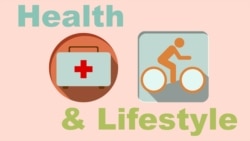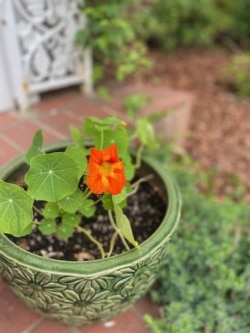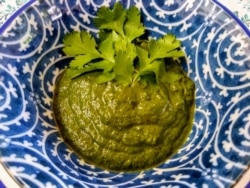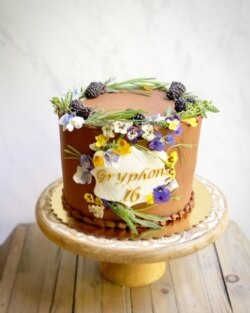From VOA Learning English, this is the Health & Lifestyle report.
Flowers are an important part of our natural world. Their beauty and smell can make us happy. Flowers serve as food for insects, birds, and animals. And they can also feed us!
Some flowers add color, unexpected taste, and beauty to food and drinks. And more people are adding them to their meals. To find out more, we talked with a few Americans who like to grow and eat their own flowers.
Kathy Jentz is the publisher of Washington Gardener magazine. She also gives talks to Washington, D.C. area gardeners. She tells them how to grow and use edible flowers.
Preparation
Jentz says the way to prepare most edible flowers for your next dish or meal is to wash them lightly under water. Then remove the white parts of the flower. She also says to cut off the pistil and stamen.
When speaking about edible flowers, Jentz often begins with three talking points:
- Know your flowers. Which ones are safe to eat?
- Know the source. Where did the flowers come from?
- Know your allergies. Which plants are you allergic to?
Know your flowers.
Some flowers are poisonous and can make you sick. There are a few flowers that people think are edible, Jentz says, even though they are poisonous.
The most common are buttercup and sweet pea. She says the flower of the sweet pea should not be mixed up with the flower of the pea plant, which is a vegetable. Other poisonous flowers are azalea, wisteria, and fox glove.
Now, here is a quick list of common edible flowers.
One of the best edible flowers to start with is the dandelion. Jentz says they are nutritious, and you can eat the entire plant, not just the flower. This is not true for many edible flowers.
Nasturtium
Nasturtium is easy to grow and, Jentz says, has a peppery taste. It is perfect for container gardening and for people living in a hot, big city. This flower often grows well in very difficult conditions.
“A container-grown flower that works really is nasturtium. It actually prefers container growing to being in the ground. The worst conditions you can give nasturtium -- the better it grows.”
Many people add nasturtium to fruit or green salads. One such person is Elizabeth Lyttleton, a mother and cycling activist in the D.C. area. In warm weather, Lyttleton says she grows nasturtium on her front doorstep. She likes to add its flowers to salads or serve with other foods.
Herb flowers
Also, in the D.C. area, Roshani Kothari says she has been growing and eating edible flowers for many years. She says that herbs are great ways to get into the world of edible flowers. Flowers from mint, rosemary, dill, oregano, cilantro, and sage add a little flavor of the herb. But they are not as strong as the leaves of the plant.
Kothari says one of her favorite herbs is cilantro.
“And cilantro is easy to grow in a pot. If you let it go to flower, it will come back year after year. And um, it’s used in so many different cultures. For example, I’m from India originally from the state of Gujarat and we use cilantro as a garnish in all the dishes we make. Without cilantro it’s not quite … quite done yet!”
Know the source of the flowers
Experts say the safest way to eat edible flowers is to grow them yourself. If you buy from a farmer’s market or a farmer, ask them directly if they used any chemicals. Be careful buying from a food or flower store. Their flowers may have been treated with dangerous chemicals.
If you go outdoors to pick edible flowers, says Kathy Jentz, do so in a safe area. Do not collect flowers from an area where dog owners walk their dogs or where chemical treatments have been used.
Borage
Jentz says her personal favorite edible flower is borage. She says the plant’s blue star-shaped flowers taste like cucumbers. So, borage can go with many dishes.
“My personal favorite is borage. The flower petals smell and taste like cucumber. The fact that you can add it on fruit salads, throw it in your gazpacho or use it to garnish a drink is a nice bonus.”
Violets
Violets are another popular edible flower. They have a sweet flavor. Use the violets in salads, sweet treats, and drinks.
Also, Jentz says violets can last a long time when left in a sealed container in the refrigerator. But she adds it is important to cut the flowers at the right time -- just as they open.
This is not true of all edible flowers. Some wilt quite fast. To avoid this, Jentz says you can use the method people have been using for centuries – dry them.
Vegetable flowers
Kothari explains that it is important to know how plants grow. Vegetables send out edible flowers if you let them go to seed.
However, if you take all the flowers from your vegetable plants, our experts warn, you will not have any vegetables! If you want to harvest the flowers of vegetables, Jentz suggests growing a vegetable plant just for its flowers.
Chamomile
Chamomile flowers are small and taste like apple. Chamomile is often used in tea. Jentz says chamomile flowers dry nicely and they keep their flavor.
However, the website WebMD warns avoid chamomile “if you are allergic to these plants: ragweed, daisies, marigolds, or chrysanthemums.
Know your own allergies
If you have allergies to ragweed and other types of pollen, Jentz advises to avoid any flower in the daisy family.
Also, if you suffer from allergies or have other food sensitivities, Jentz suggests trying new edible flowers one at a time. If you eat many different ones for the first time and then get sick, you will not know which one made you sick.
Jentz also gives this warning: Do not give edible flowers to any child under the age of four.
And that’s the Health & Lifestyle report. Have fun trying different edible flowers.
I’m Anna Matteo.
In the Comments Section, let us know if you use flowers in your cooking and which ones! And feel free to share a recipe.
Anna Matteo wrote this story for VOA Learning English. George Grow was the editor.
________________________________________________________________
Words in This Story
pistil – n. the part in the center of a flower that is made up of the stigma, style, and ovary and produces the seed
stamen – n. the part of a flower that produces pollen and is made up of an anther and a filament
allergy – n. a medical condition that causes someone to become sick after eating, touching, or breathing something that is harmless to most people allergic – adj.
peppery – adj. having a lively, aggressive, or somewhat shocking quality
herb – n. a plant or a part of a plant that is used as medicine or to give flavor to food
garnish – n. something (such as lemon wedges or parsley) used
to decorate or flavor food or drink
petal – n. one of the soft, colorful parts of a flower
refrigerator – n. a device or room that is used to keep things (such as food and drinks) cold
wilt – v. of a plant : to bend over because of not having enough water














